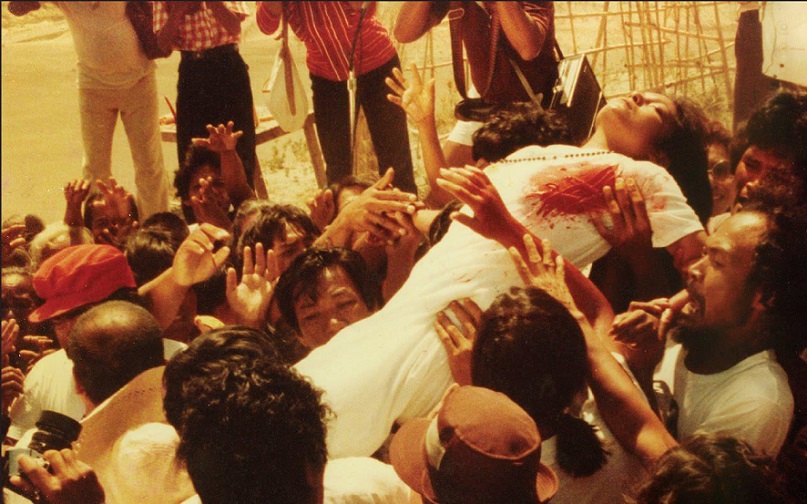A new chapter in the life of Nora Aunor unfolds Thursday, June 16, 2022 when she appears at the Rizal Hall in Malacanang to be conferred the title National Artist for Film and Broadcast.
Others to be given the prestigious National Artists award are Marilou Diaz-Abaya, Ricardo “Ricky” Lee, Gemino Abad, Fides Cuyugan-Asensio and Antonio “Tony” Mabesa.
To sum up, no one can dispute that she outdid herself in such classic films in Lino Brocka’s Bona, Ishmael Bernal’s Himala and Brillante Mendoza’s Thy Womb.
True, her presence in any film is an invitation to another acting award.
But unknown to many, Nora has also done theater, and, while modest compared to her film output, these appearances have been equally memorable.
In 1976, Lupita Aquino Kashiwahara (sister of Ninoy) directed a landmark film called “Minsa’y Isang Gamu-gamo” (Once A Moth), which won best picture, best director, best story, best screenplay and best editing in that year’s Famas Awards.
While the best actress trophy eluded Nora, everyone in the cinema world was convinced her role as Corazon de la Cruz, whose brother was killed in an American military reservation, was second to none that year.
In 1991, 15 years after the critical success of the Kashiwahara film, a stage adaptation of “Minsa’y Isang Gamu-Gamo” was conceived by the Philippine Educational Theater Association, with award-winning writer Rodolfo Vera tapped to write the script and Soxy Topacio as director.
Aunor debuted as stage actress at the Raha Sulayman Theater in Fort Santiago.
Vera recalled that “Minsa’y Isang Gamu-gamo” was chosen by Peta as part of its season in response to the anti-US bases issue, which was the burning issue at that time, with the Senate about to vote on the fate of the RP-US bases treaty.“Peta talked to Marina Feleo-Gonzales, the scriptwriter of the film, and delegated me to adapt it for the stage,” he said.
“The play was quite faithful to the film script. All I really had to do was to restructure it a bit so that the scenes could play out longer and minimize the numerous cuts that film can afford. Also, I remember asking Marina how she imagined Corazon (Nora’s character) at the present time. She said she would see her as a committed member of the anti-US bases movement. So I added a few scenes that would help set that up in the end. Other than those tweaks, if you watch the film, much of the memorable lines and scenes, about 70 percent of them, were there on stage.”
Since this would be her stage debut, “It gave her much anxiety at the beginning,” recalled Vera. “And in the process, she created her own ‘ritual’ so to speak. Because she realized that theater required her to memorize all her lines in one go (unlike in film where you needed to memorize the lines of any particular sequence being shot), she developed the habit of writing (on a notebook) all her lines—that was her method of memorizing them.She also remarked during one rehearsal that, now, she understood the story and its details a lot better than when they were shooting the film. She said she lost track of the real flow of the story since they were not shooting the film chronologically. But in theater, she would have to perform it from beginning to end. So, she learned how to let her emotional track organically develop and grow towards the climax.”
Opening night brought out the best in Aunor, said Vera. “‘Minsa’y Isang Gamu-gamo’ was one of Peta’s greatest hits. Imagine Nora, live, on stage, reprising her role as the nurse who wanted to go to America. The movie was one of the best films that ever screened at the Metro Manila Film Festival (along with ‘Insiang,’ ‘Ganito Kami Noon, Paano Kayo Ngayon’—one of those films that defined the ‘second golden age of Philippine cinema’ back in 1976). And seeing Nora on stage, no matter how small her physical stature was—she exuded the hugeness of a giant. All eyes were focused on her whenever she was on stage. Your eyes just searched for her in crowd scenes— and you’d find her, because she evoked a bigness that few actors could ever display.
After “Gamu-Gamo” came the play “DH” (Domestic Helper”), written by Ricky Lee. “DH” had a good Manila reception in 1992 and, as a result, it toured the United States and a few other countries.
“In this play, she played a number of roles (all domestic helpers), and in each she was brilliant,” said Vera. “Her performance was just as riveting as the first time in ‘Gamu-Gamo.’ This play, I think, was more challenging for her kasi she had longer lines, a lot more monologues and four roles to tackle! She was funny, tragic, broken and transcendent.”
Aunor’s last theater outing was in a production of the classic Greek play “Trojan Women” in 1994, directed by Peta founder Cecile Guidote Alvarez.
Alvarez said Aunor performed for free in this production, and her superb acting made a hardcore Noranian out of her.

